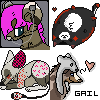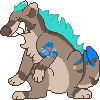Fine, I'z do it myself! 3: <-*sad kitten face* I got impatient and found the form by myselfz...
pet's gender: Female
pet's name: Bast Jr./Bastthe second... Bast the Great ...Well call her Bast for short XD
species name: Bitumen-A mummy is a body, human or animal, whose skin and organs have been preserved by either intentional or incidental exposure to chemicals, extreme coldness (ice mummies), very low humidity, or lack of air when bodies are submerged in bogs, so that the recovered body will not decay further if kept in cool and dry conditions. Some authorities restrict the use of the term to bodies deliberately embalmed with chemicals, but the use of the word to cover accidentally desiccated bodies goes back at least to the 1730s.
Mummies of humans and other animals have been found all around the world, both as a result of natural preservation through unusual conditions, and as cultural artifacts. Over one million animal mummies have been found in Egypt, many of which are cats.[1] The oldest known naturally mummified human corpse is a decapitated head dated as 6,000 years old, found in 1936 at the site named Inca Cueva No. 4 in South America.[2]
In addition to the well-known mummies of Ancient Egypt, deliberate mummification was a feature of several ancient cultures in areas of South America and Asia which have very dry climates. There are more than 1000 mummies in Xinjiang, China.[3] The oldest-known deliberate mummy is a child, one of the Chinchorro mummies found in the Camarones Valley, Chile, and dates from around 5050 BC.[4]
Contents [hide]
1 Etymology and meaning
2 The Egyptian mummification process
2.1 Scientific study of Egyptian mummies
2.2 Post-interment care
3 Deliberate mummification in other cultures
3.1 South America
3.1.1 Chinchorro Mummies
3.2 Inca Mummies
3.3 Canary Islands
3.4 Italy
4 Natural mummification
5 Asia
5.1 China
5.2 Siberia
6 Europe
6.1 Italy
6.2 Czech Republic
6.3 Denmark
6.4 Bog bodies
7 North America
7.1 Greenland
7.2 Mexico
8 Self-mummification
9 Modern mummies
9.1 Commercial mummification
9.2 Plastination
9.3 Treatment of ancient mummies in modern times
10 In popular culture
11 See also
12 References
13 External links
[edit]Etymology and meaning
Mummy (sˁḥ)
in hieroglyphs
The English word mummy is derived from medieval Latin mumia, a borrowing of the Persian word mūm (موم), which means "bitumen".[5] Because of the blackened skin, bitumen was once thought to be used extensively in ancient Egyptian embalming procedures.[citation needed] (See also: Mummia.) In English "mummy" as a term for a "medical preparation of the substance of mummies" is recorded from c. 1400, earlier than the sense of a complete body, with Richard Hakluyt in 1599 complaining that "these dead bodies are the Mummy which the Phisistians and Apothecaries doe against our willes make us to swallow".[6]
The OED gives as its sense 3 "the body of a human being or animal enbalmed (according to the ancient Egyptian or some analogous method) as a preparation for burial", citing sources from 1615 onwards, later than the first uses of other senses that include ground up mummy used as "a medicinal preparation", which dates to c. 1400.[7] However sense 3c: "A human or animal body desiccated by exposure to sun or air. Also applied to the frozen carcase of an animal imbedded in prehistoric ice", is cited to Chamber's Cyclopaedia, 1727-41, and the Victorian zoologist Francis Trevelyan Buckland.[8]
[edit]The Egyptian mummification process
The first evidence of intentional mummification in Egypt dates to 3500 B.C.[9] Parts of mummified human bodies recovered from Hierakonpolis exhibit evidence of resin and linen wrappings.[9]
The earliest intact Egyptian mummy, ID #32751, dates to approximately 3400 BC, and is currently held in the British Museum.[10] Mummy 32751 was previously nicknamed "Ginger" for its hair color, but this practice was stopped in 2004, in order to afford more dignity to human remains. Mummy #32751 was an adult male; the exact age at death is uncertain. It was apparently preserved by direct contact with the dry desert sand, though it is uncertain whether the mummification was intended. Pottery vessels were recovered from the grave, but their significance is uncertain.[10]
From the Middle Kingdom onwards, embalmers used salts to remove moisture from the body. The salt-like substance found on the banks of salt lakes, natron, dried out and preserved more flesh than bone. Once dried, mummies were ritualistically anointed with oils and perfumes. The emptied body was then covered in natron, to speed up the process of dehydration and prevent decomposition. Natron dries the body up faster than desert sand, preserving the body more effectively. Often finger and toe protectors were placed over the mummy's fingers and toes to prevent breakage. They were wrapped with strips of white linen to protect the body from being damaged. After that, they were wrapped in a sheet of canvas to further protect them. Many sacred charms and amulets were placed in and around the mummy and the wrappings. This was intended to protect the mummy from harm and to give good luck to the Ka of the mummy. Once preserved, they were lain to rest in a sarcophagus inside a tomb, where it was believed that the mummy would rest eternally. The mummy's mouth would later be opened in an ritual designed to symbolize breathing, giving rise to legends about resurrected mummies.[11] In some cases, a mummy has been discovered in an unmolested tomb, only to be found in a state of advanced decomposition due to the proximity of the water table. This was the case with the discovery in 1998 of the mummy of Iufaa, an Egyptian priest and administer who lived around 500 BC.
The most famous Egyptian mummies are those of Seti I and Rameses II (13th century BC). From
Wikepedia, Wikepedia x3 Not very oringal.

Also could be known as 'Living TP' (because it seems they are wrapped in toilet paper XD) instead of 'Living Dead' (ZOMBIEEEEESSSS XD) That reminds me of Fido the friendly zombie, but let's not get into that at the moment...
pet's favourite game:
pet's favourite food: Very, very fancy and expensive cat foods {since they worship the cats ^^} ...or what mummy cats eat, of course-mummy mice & birds ect. She likes the cat foods better
pet's personality: Bast is so called a legendary warrior since 1. she is daughter of the goddess Bastet and 2. She had been destinied for centuries to be Jade's legendary partner in good doings and heroism. Bast is actually older than anyone would have imagined, and underneath those old wrappings she is a beautiful, glossy colored cat like her mother had once been. But Bastet-I trust people know commonly other goddesses and gods in different mythologies, were, in fact,
immortal-never really died but suffered something like it from the Eye of Ra. Therefore that is how Bastet gave birth, she never really was dead but not alive either. (if that makes sense) Bastet wrapped her kitten so no one would suspect she had this bundle. anyway bast's personality-she is very wise for she (and she's immortal too) had waited for centuries for this day and has a very wise, smart way of speaking, but not arrogant at all. You could, perhaps, describe her sweet and kind. She is certainly loyal but is independent in her own ways, like all cats are. She likes doing it her way. She never even hesitates when meeting a new person and decides if she'll like them or not. Cats have extreme senses, (and it seemed when my cat Peanut met my brother, he immeditatly took no interest or liking in him) and can sense what type of person this is, but this isn't really like mind-reading, just watching from the smallest movements and the way they talk can a cat recognize these things. Really it is the smarts. Bast's personality should not be confused with a know-it-all, but a sort of tender-hearted, very wise sort of animal, who cares for the things needed to be cared about and will have nothing to do with the things she dislikes. And to a cat, that is that.
More of her really attitude to things like food she'll be given ect. like you will be doing, she is most likely to react how she feels herself. Cats can, unfortuanlty, be very blunt and telling you abruptly in an almost rude way "this is how it is going to be". they like to be in charge, and you will recognize how Bast recognizes you when you feed/play with her. Therefore do not take it out on me, pretend Bast is real and what you're doing on here is real and be careful, cats usually make their minds up quick.
Now I shall do this:
Woodwolves wrote:*Feeds*
*Bast cautiously pads up and sniffs the food you have placed before her. Even though she is blunt to others, she doesn't like the action returned, and bends over the food, wondering what it is. She glances at you and gives you a twinge of her whiskers, though she enjoyed the food, she is annoyed at your behavior.*
Don't take it seriously, just playin around ^^













